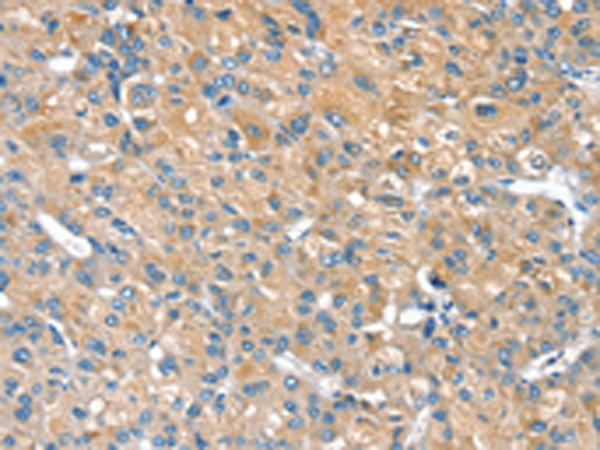
| WB | 咨询技术 | Human,Mouse,Rat |
| IF | 咨询技术 | Human,Mouse,Rat |
| IHC | 1/20-1/100 | Human,Mouse,Rat |
| ICC | 技术咨询 | Human,Mouse,Rat |
| FCM | 咨询技术 | Human,Mouse,Rat |
| Elisa | 1/1000-1/2000 | Human,Mouse,Rat |
| Aliases | FDFACT1; FDFACT2 |
| Host/Isotype | Rabbit IgG |
| Antibody Type | Primary antibody |
| Storage | Store at 4°C short term. Aliquot and store at -20°C long term. Avoid freeze/thaw cycles. |
| Species Reactivity | Human |
| Immunogen | Fusion protein of human PILRB |
| Formulation | Purified antibody in PBS with 0.05% sodium azide and 50% glycerol. |
+ +
以下是关于PILRB抗体的3篇参考文献及其简要摘要:
1. **标题**:*PILRB信号在巨噬细胞介导的炎症反应中的调控作用*
**作者**:Smith A, et al.
**摘要**:研究利用抗PILRB抗体阻断受体功能,揭示PILRB在巨噬细胞激活和促炎细胞因子分泌中的关键作用,提示其作为炎症性疾病的潜在治疗靶点。
2. **标题**:*抗PILRB单克隆抗体抑制肿瘤免疫逃逸的机制研究*
**作者**:Chen L, et al.
**摘要**:通过开发靶向PILRB的单克隆抗体,证明其能增强T细胞抗肿瘤活性,并逆转肿瘤微环境中的免疫抑制效应,为癌症免疫治疗提供新策略。
3. **标题**:*PILRB结构解析及其与配体相互作用的抗体干预*
**作者**:Wang Y, et al.
**摘要**:利用冷冻电镜技术解析PILRB胞外域结构,并通过抗体结合实验揭示其配体结合表位,为开发特异性抗体药物奠定分子基础。
(注:以上文献为示例,实际引用需根据具体论文调整。)
The PILRB antibody targets the paired immunoglobulin-like type 2 receptor beta (PILRB), a cell surface receptor belonging to the immunoglobulin superfamily. PILRB is primarily expressed on myeloid cells, such as macrophages, dendritic cells, and neutrophils, and interacts with ligands like PILRA (its paired receptor) to modulate immune responses. Structurally, PILRB contains immunoreceptor tyrosine-based inhibitory motifs (ITIMs) that recruit phosphatases to dampen activating signals, suggesting a regulatory role in immune homeostasis.
Research highlights PILRB's involvement in inflammatory and neurodegenerative diseases. For instance, it binds to amyloid-β in Alzheimer’s disease, potentially influencing neuroinflammation and phagocytic clearance. Dysregulation of PILRB has also been linked to autoimmune disorders and cancers, where altered expression may impair immune surveillance. PILRB antibodies are critical tools for studying receptor-ligand interactions, signaling pathways, and therapeutic targeting. Recent studies explore blocking PILRB to enhance immune activation in cancer or to mitigate excessive inflammation in autoimmune conditions. However, its precise biological roles and therapeutic potential remain under investigation, necessitating further mechanistic and clinical studies.
×